Best Oak Trees for Gardens: Finding Your Perfect Match
Published: August 22, 2025 at 9:05:51 AM UTC
Oak trees stand as living monuments in our landscapes, offering unmatched beauty, shade, and ecological value. With their majestic presence and remarkable longevity, these iconic trees can transform an ordinary garden into an extraordinary sanctuary. But choosing the right oak for your space requires careful consideration – not all varieties are suitable for home gardens, and selecting the wrong one could lead to future problems. In this comprehensive guide, we'll explore the most garden-friendly oak species, helping you navigate the hundreds of available varieties to find the perfect match for your landscape. From compact varieties ideal for smaller spaces to magnificent shade trees for larger properties, you'll discover how to select, plant, and care for these remarkable trees.
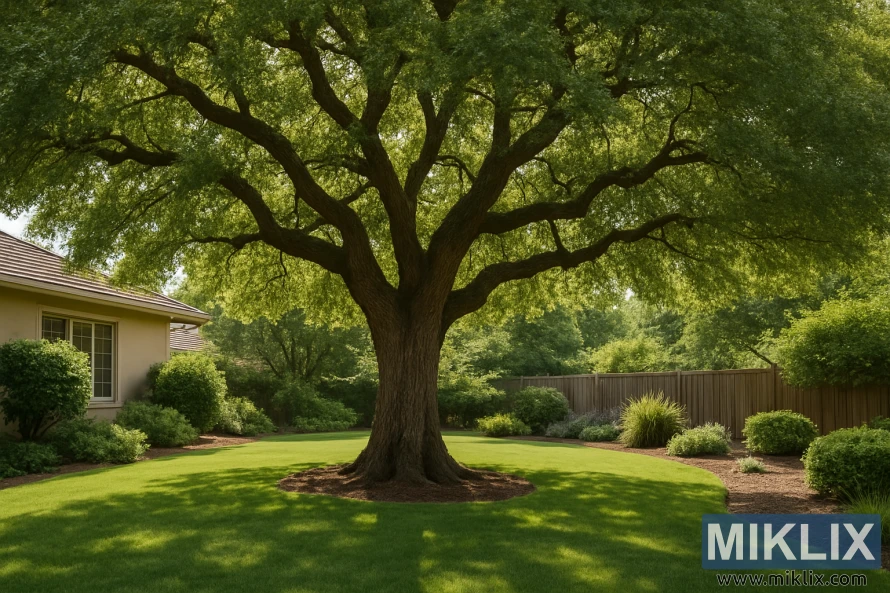
Why Plant an Oak Tree in Your Garden?
Before diving into specific varieties, let's consider why oak trees make exceptional additions to home gardens:
Landscape Value
- Increase property value by thousands of dollars
- Create exceptional shade and cooling effects
- Provide stunning seasonal color changes
- Offer architectural structure and focal points
Ecological Benefits
- Support more wildlife than any other tree genus
- Produce acorns that feed birds and mammals
- Host beneficial insects and pollinators
- Improve air quality and reduce carbon footprint
Ready to enhance your garden with an oak tree?
Selecting the right variety is crucial for long-term success. Consider your space, climate, and preferences as you explore the options below.
Understanding Oak Tree Types
Oak trees (Quercus species) belong to the Beech family and include over 500 varieties worldwide. Before selecting a specific variety, it's helpful to understand the two main categories of oaks:
Red Oak Group
- Features pointed leaf lobes with bristle tips
- Acorns mature over two years
- Often display vibrant red fall color
- Includes Northern Red Oak, Pin Oak, Scarlet Oak, and Willow Oak
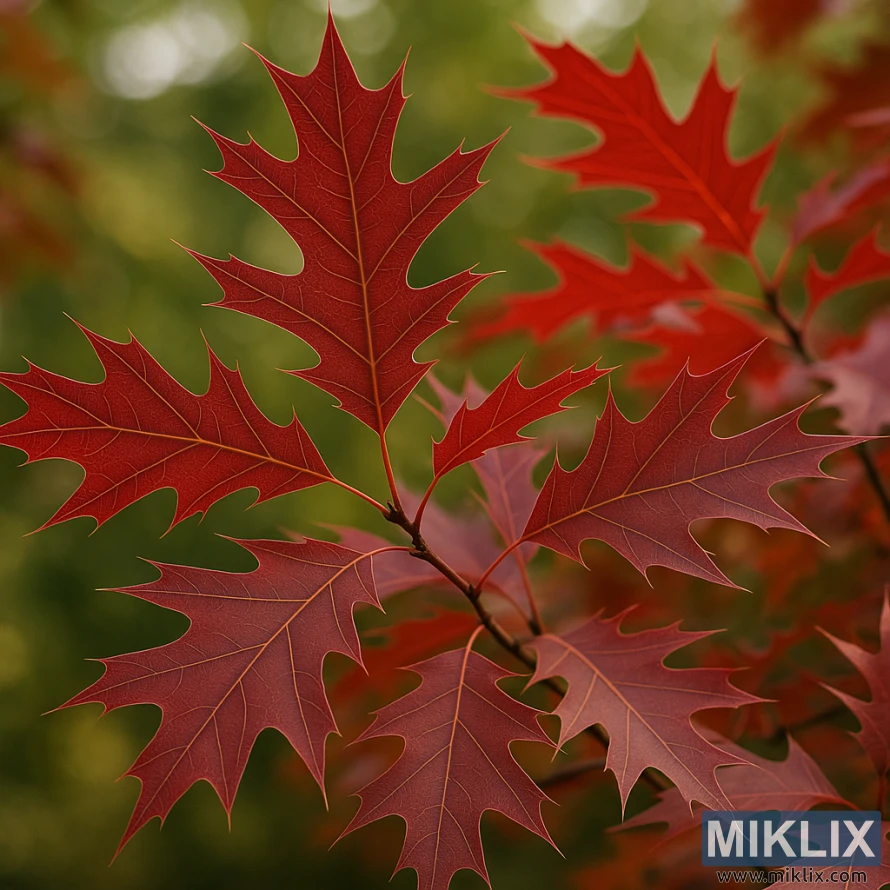
White Oak Group
- Displays rounded leaf lobes without bristles
- Acorns mature annually
- Often show golden to russet fall color
- Includes White Oak, Bur Oak, Swamp White Oak, and Chinkapin Oak
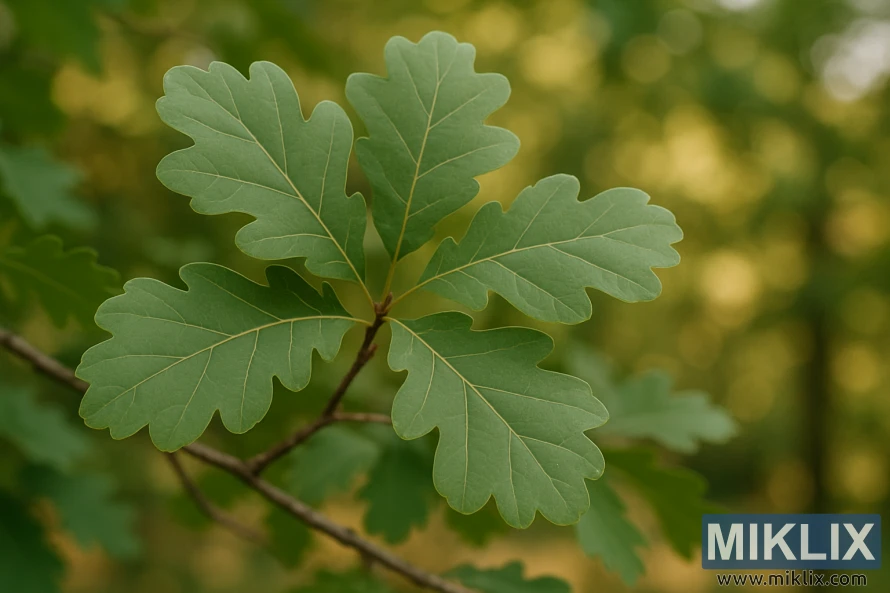
Key Factors to Consider When Choosing an Oak Tree
Selecting the best oak trees for gardens requires careful consideration of several important factors:
Space Requirements
Consider the mature size of the oak tree. Many species can reach 50-100 feet tall with equally wide spreads, while compact varieties may stay under 35 feet. Ensure you have adequate space for the tree's ultimate size.
Growth Rate
Some oaks grow quickly (2+ feet per year), while others develop slowly. Fast-growing varieties like Pin Oak and Northern Red Oak provide quicker shade, while slower-growing species often live longer.
Climate Adaptability
Match the oak species to your hardiness zone. Some varieties thrive in cold northern climates (Zones 3-5), while others prefer warmer southern regions (Zones 7-9).
Soil Conditions
Different oak species have specific soil preferences. Some tolerate wet conditions (Swamp White Oak, Pin Oak), while others prefer well-draining soil (White Oak) or can handle drought (Bur Oak).
Maintenance Needs
Consider leaf drop, acorn production, and pruning requirements. Some varieties produce fewer acorns or require less maintenance than others.
Aesthetic Preferences
Oak trees offer various leaf shapes, fall colors, and growth habits. Consider which aesthetic qualities matter most for your landscape design.
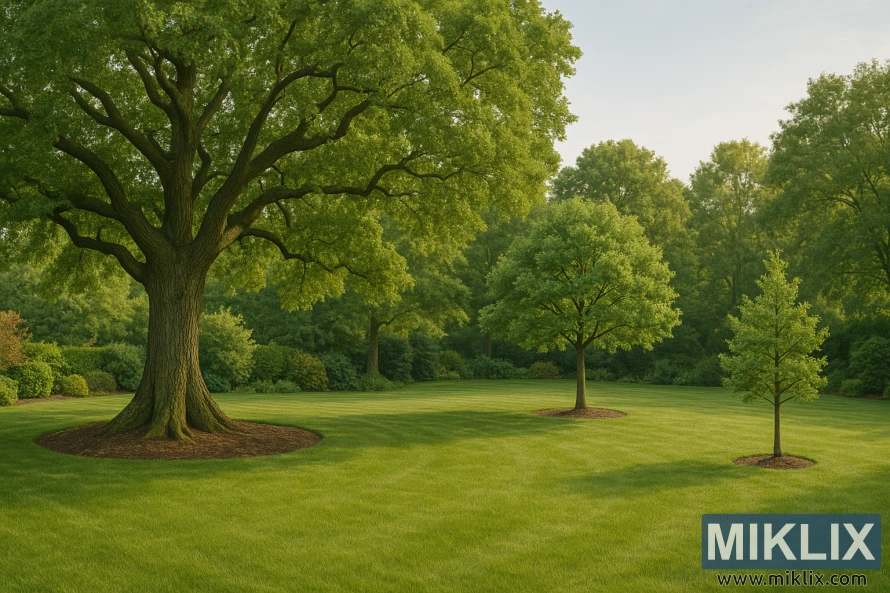
Top Oak Tree Species for Home Gardens
Based on adaptability, size, and garden-friendly characteristics, here are our top recommendations for the best oak trees for gardens:
Pin Oak (Quercus palustris)
Key Features:
- Distinctive pyramidal shape with unique branching pattern
- Fast growth rate (2+ feet per year)
- Reaches 60-70 feet tall, 25-40 feet wide
- Russet to bright red fall color
- Tolerates wet soil conditions and urban environments
Pros
- Establishes quickly for faster shade
- Adapts well to various soil conditions
- Excellent street and lawn tree
- Attractive fall color
Cons
- Lower branches may require pruning
- Prefers acidic soil (yellows in alkaline soil)
- Holds dead leaves in winter
Best For Medium to large gardens in Zones 4-8, especially in areas with moist soil or periodic flooding.
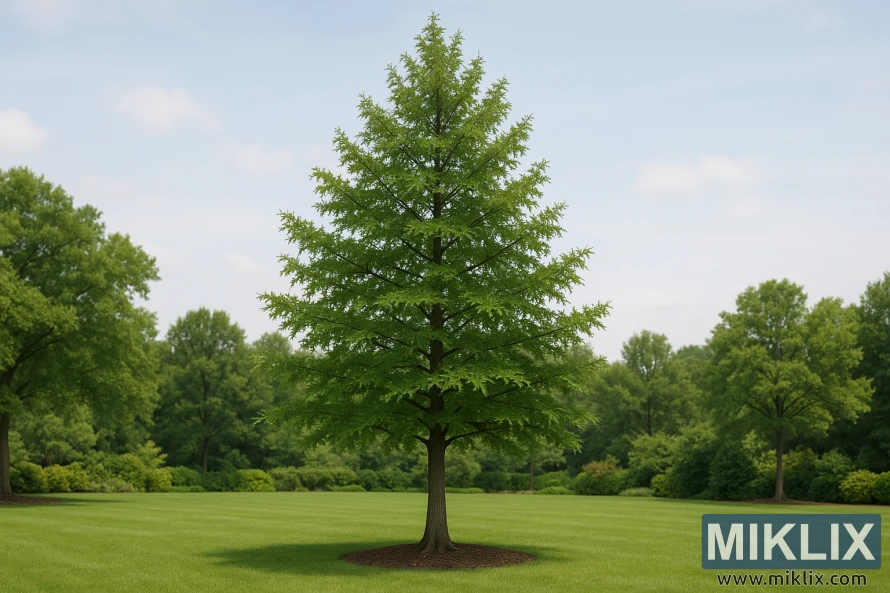
White Oak (Quercus alba)
Key Features:
- Majestic, broad-spreading crown
- Slow to moderate growth rate
- Reaches 50-80 feet tall, 50-80 feet wide
- Purple-red to burgundy fall color
- Light gray, flaky bark adds winter interest
Pros
- Exceptional longevity (500+ years)
- Superior wildlife value
- Drought-tolerant once established
- Disease and pest resistant
Cons
- Slow initial growth
- Requires significant space
- Difficult to transplant when larger
Best For Large properties in Zones 3-9 where a long-term, majestic shade tree is desired.
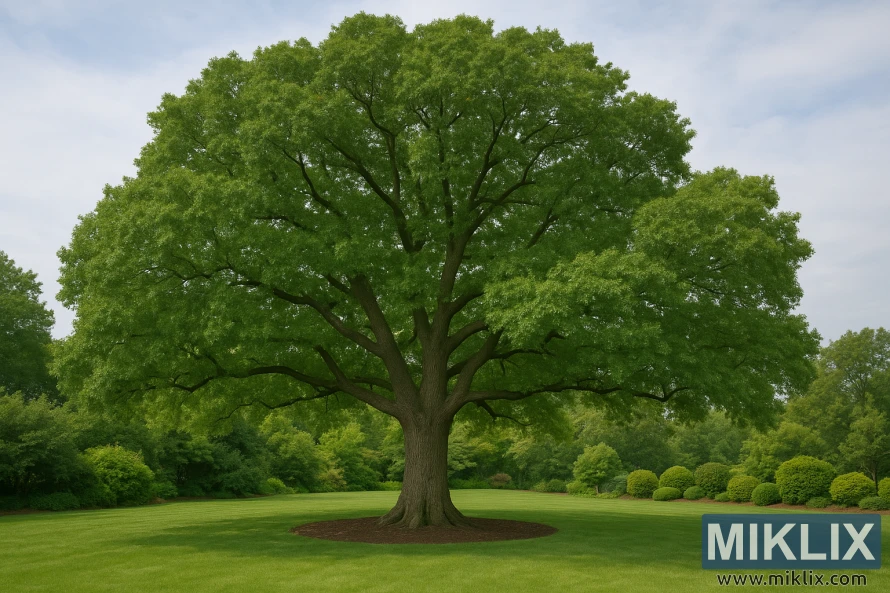
Swamp White Oak (Quercus bicolor)
Key Features:
- Rounded crown with slightly drooping branches
- Moderate growth rate
- Reaches 50-60 feet tall, 40-60 feet wide
- Leaves with dark green top, silvery-white underside
- Yellow to brown-gold fall color
Pros
- Excellent tolerance for wet sites
- Adapts to various soil conditions
- Transplants more easily than White Oak
- Urban-tolerant and pollution-resistant
Cons
- Less dramatic fall color than some oaks
- May struggle in very dry conditions
- Requires acidic soil for best growth
Best For Gardens with poorly drained or occasionally wet soils in Zones 4-8.
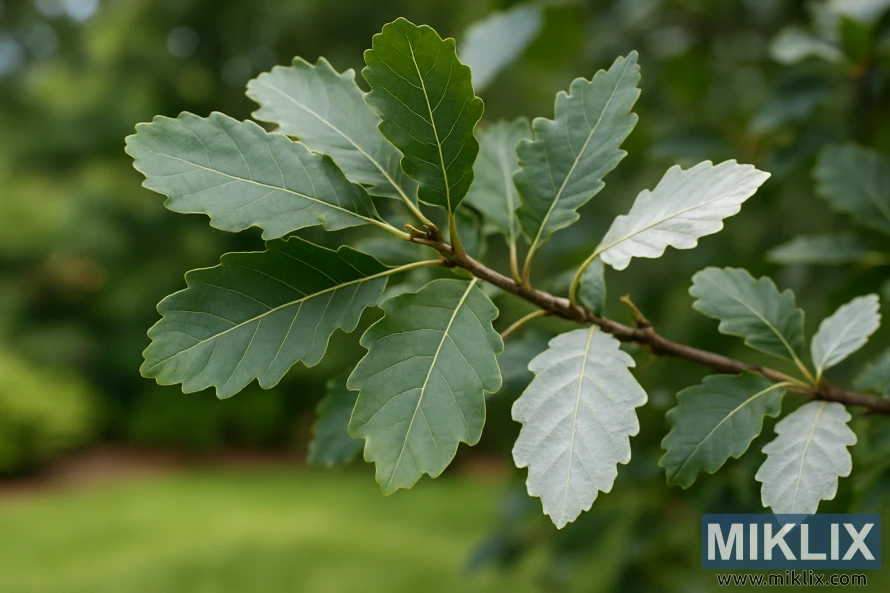
Northern Red Oak (Quercus rubra)
Key Features:
- Broad, symmetrical rounded crown
- Fast growth rate (2+ feet per year)
- Reaches 60-75 feet tall, 40-50 feet wide
- Brilliant red fall color
- Straight trunk with dark, furrowed bark
Pros
- Faster shade development
- Tolerates urban conditions
- Transplants easily
- Spectacular fall display
Cons
- Susceptible to oak wilt disease
- Less drought-tolerant than some oaks
- Requires acidic soil
Best For Medium to large gardens in Zones 4-8 where faster growth and fall color are priorities.
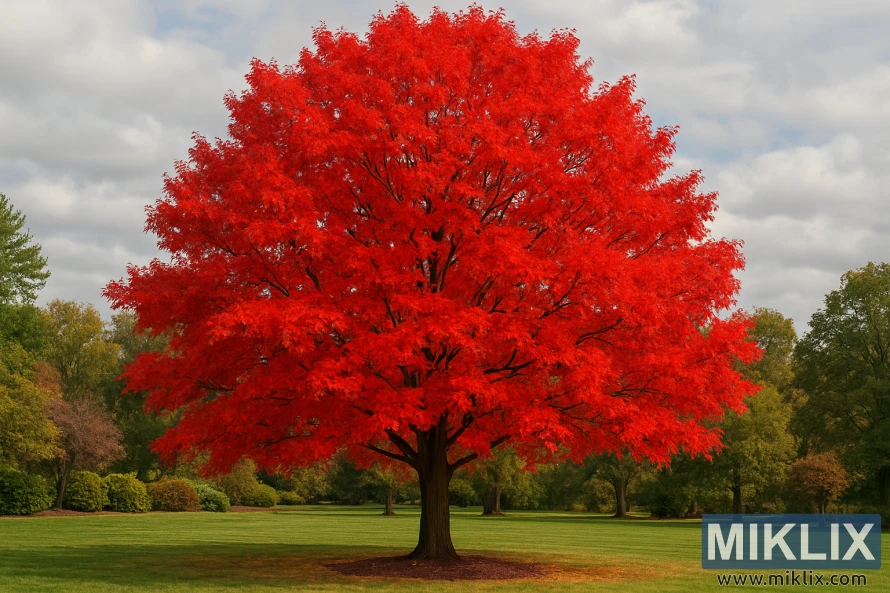
Compact and Small-Space Oak Options
Limited space doesn't mean you can't enjoy an oak tree. These compact varieties are perfect for smaller gardens:
Dwarf Chinkapin Oak
A compact oak reaching just 15-20 feet tall with a similar spread. Features distinctive chestnut-like leaves and excellent drought tolerance. Perfect for small yards in Zones 5-9.
Crimson Spire™ Oak
A columnar hybrid growing 45 feet tall but only 15 feet wide. Combines the narrow form of English Oak with the red fall color of White Oak. Ideal for narrow spaces in Zones 4-8.
Skinny Genes® Oak
An extremely narrow oak reaching 45 feet tall but just 8-10 feet wide. Perfect for tight spaces where vertical accent is desired. Thrives in Zones 4-8.
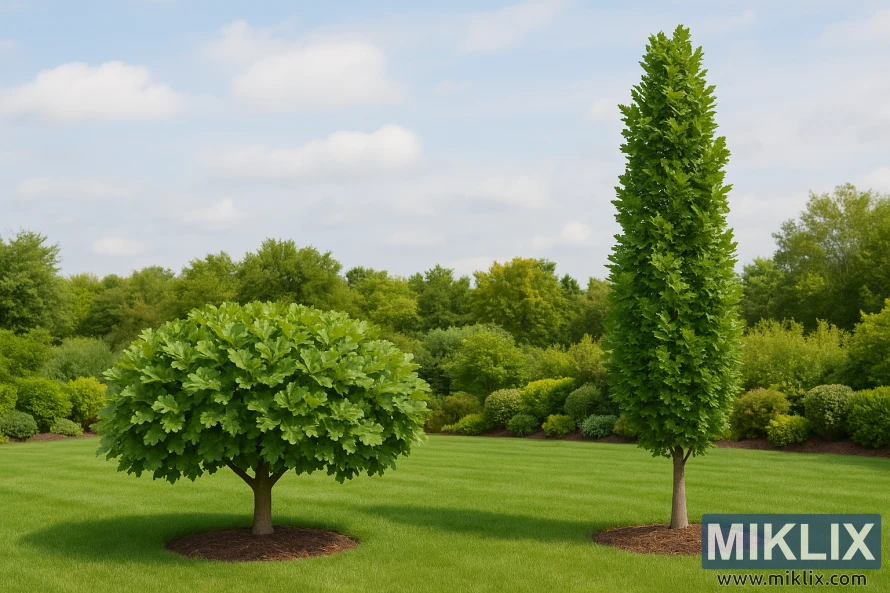
Oak Tree Comparison: Finding Your Perfect Match
Use this comprehensive comparison table to quickly identify which oak species best suits your garden needs:
| Oak Species | Mature Size (H×W) | Growth Rate | Hardiness Zones | Special Features | Best Garden Use |
| Pin Oak | 60-70' × 25-40' | Fast | 4-8 | Pyramidal shape, wet-tolerant | Lawn tree, wet areas |
| White Oak | 50-80' × 50-80' | Slow | 3-9 | Long-lived, wildlife value | Specimen, shade |
| Swamp White Oak | 50-60' × 40-60' | Moderate | 4-8 | Wet-tolerant, bicolor leaves | Wet sites, urban areas |
| Northern Red Oak | 60-75' × 40-50' | Fast | 4-8 | Brilliant red fall color | Shade, street tree |
| Bur Oak | 70-80' × 60-80' | Slow | 3-8 | Drought-tolerant, corky bark | Large properties |
| Dwarf Chinkapin Oak | 15-20' × 15-20' | Slow | 5-9 | Compact size, drought-tolerant | Small gardens |
| Crimson Spire™ Oak | 45' × 15' | Moderate | 4-8 | Columnar form, red fall color | Narrow spaces |
Planting and Care Guide for Garden Oak Trees
Planting Your Oak Tree
Site Selection
- Choose a location with full sun (minimum 6 hours daily)
- Ensure adequate space for mature size (check the comparison table)
- Position at least 15-20 feet from structures and underground utilities
- Consider soil drainage needs based on species
Planting Steps
- Dig a hole twice as wide as the root ball but no deeper
- Position the tree with the root flare at soil level
- Backfill with native soil (avoid amendments)
- Water thoroughly to eliminate air pockets
- Apply 3-4 inches of mulch in a ring (not touching trunk)
Oak Tree Care
Watering
Water deeply but infrequently during the first 2-3 years. Once established, most oaks are drought-tolerant, though Pin Oak and Red Oak appreciate regular moisture during dry periods.
Fertilizing
Apply slow-release tree fertilizer in early spring if growth seems slow or foliage is pale. Follow package rates based on trunk diameter. Avoid fertilizing after mid-summer.
Pruning
Prune oak trees during dormant season (winter) to prevent oak wilt disease. Focus on removing dead, damaged, or crossing branches. Establish a strong central leader when young.
Important Oak Care Tip
To prevent oak wilt disease, avoid pruning oak trees during the growing season (April through July) when beetles that spread the disease are most active. Winter pruning is safest for oak health.
Create a Lasting Legacy with the Best Oak Trees for Your Garden
Oak trees represent one of the most rewarding investments you can make in your garden landscape. These magnificent trees offer immediate benefits of beauty and habitat while growing into living legacies that can span generations. By selecting the best oak trees for your garden's specific conditions, you're creating a natural monument that will enhance your property and support local wildlife for decades or even centuries to come.
Whether you choose the fast-growing shade of a Pin Oak, the majestic spread of a White Oak, or the compact elegance of a dwarf variety, your oak tree will become an increasingly valuable asset with each passing year. The key is selecting the right species for your space, planting it correctly, and providing proper care during its establishment period.
Frequently Asked Questions About Oak Trees for Gardens
How long does it take for an oak tree to produce shade?
Fast-growing varieties like Pin Oak and Northern Red Oak can begin providing meaningful shade within 5-10 years of planting. Slower-growing species like White Oak and Bur Oak may take 15-20 years to develop substantial shade canopies. The growth rate depends on soil conditions, climate, and care during establishment.
Are oak trees messy with acorn drop?
Oak trees produce varying amounts of acorns, with heavy production typically occurring only every 2-5 years (called "mast years"). Young oaks (under 20 years) produce few if any acorns. If acorn drop is a concern, White Oak group members tend to produce fewer acorns than Red Oak group species. Swamp White Oak and Bur Oak are often recommended for less messy acorn production.
How close to my house can I plant an oak tree?
For large oak varieties (White Oak, Bur Oak, Red Oak), plant at least 20-30 feet from foundations, sewer lines, and other structures. Compact varieties like Dwarf Chinkapin Oak can be planted 15 feet from structures. Columnar varieties like Crimson Spire™ can be placed 10-15 feet from buildings due to their narrow form. Always consider the mature canopy spread when determining placement.
Which oak trees are best for small gardens?
For small gardens, consider compact varieties like Dwarf Chinkapin Oak (15-20 feet tall and wide) or columnar forms like Crimson Spire™ Oak (45 feet tall but only 15 feet wide) and Skinny Genes® Oak (45 feet tall but just 8-10 feet wide). These varieties provide oak benefits without overwhelming limited spaces.
Further Reading
If you enjoyed this post, you may also like these suggestions:
- The Best Linden Tree Varieties to Plant in Your Garden
- The Best Birch Trees for Your Garden: Species Comparison and Planting Tips
- A Guide to the Best Trees to Plant in Your Garden
